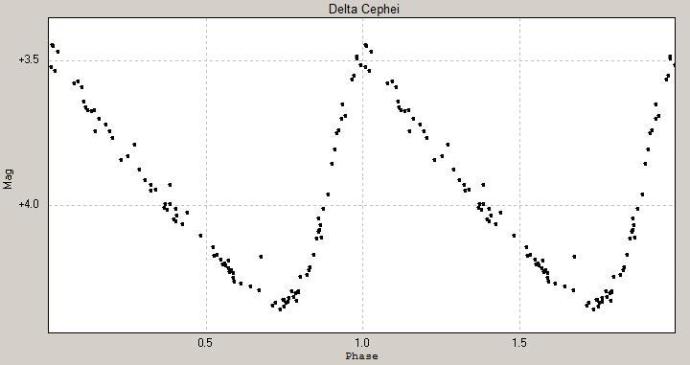A star is classed as a variable star if it appears to change brightness (as seen from Earth) over time.
The changes can come from the star itself, as the amount of energy it emits varies. Changes can also come from outside the star. For example, light from the star being blocked by an orbiting companion star.
We have known about variable stars for nearly four hundred years. The first one, Mira, was found in 1638. It pulsed over an 11-month cycle. Just over a century later in 1786, astronomers had found only ten variable stars. Today we know of more than 150,000!
We study most variable stars by measuring their brightness over time. We plot this on a graph known as a light-curve.
There are many kinds of variable star, but here are four of the most common types:
- Cepheid Variables
An important type of variable star is called a Cepheid. These are yellow, giant stars which pulsate. This pulsing is caused by the star swelling and shrinking in a regular, repeating way.
Each time the star swells, it gets cooler and fainter. As it shrinks, it gets hotter and brighter.
Image CreditThis work by ThomasK Vbg is licensed under Creative Commons Attribution Share Alike 4.0 International
CreditThis work by ThomasK Vbg is licensed under Creative Commons Attribution Share Alike 4.0 InternationalLight-curve for a Cepheid Variable However, this is complicated by how much light the star releases at each stage. The star changes its opacity (how see-through it is) during the process, changing the amount of light we see. The change in opacity is due to a layer of helium in the stars' envelope.
We call each cycle of pulsation a 'period'. Cepheids have short periods (days to weeks) which are related to the brightness of the star. This is called the period-luminosity relationship. If we know the period, we can work out the luminosity. This allows astronomers to calculate how far away these stars are.
In the 1920s, Cepheids were used to prove that there were other galaxies in the Universe.
- RR Lyrae Variables
RR Lyrae stars are like Cepheids but are far dimmer. They are often part of globular clusters. These stars also have a period-luminosity relationship which we can use to work out the distance to the cluster.
The periods of RR Lyrae stars are much shorter (a few hours to a day or 2). Their brightness varies by just 20 % in some cases to over 500 % in others!
Image CreditThis work by RJHall is licensed under Creative Commons Attribution Share Alike 4.0 International
CreditThis work by RJHall is licensed under Creative Commons Attribution Share Alike 4.0 InternationalLight-curve for a RR Lyrae Variable The increase in brightness of these stars occurs at a much faster rate than the decrease. This gives the light-curve a distinctive shape and lets us distinguish them from Cepheid variables.
- Mira Variables
Mira variable stars are cool giants which are also pulsating. The pulsations of Mira stars are large. They can vary between 5 times and 30,000 times their brightness over many months.
The variation is produced in the same way as Cepheid variables, but the opacity changes are due to a layer of hydrogen rather than helium.
Image CreditThis work by Lithopsian is licensed under Creative Commons Attribution Share Alike 4.0 International
CreditThis work by Lithopsian is licensed under Creative Commons Attribution Share Alike 4.0 InternationalLight-curve for a Mira Variable The rise and fall in brightness is much more balanced in Mira stars. This allows us to distinguish them from Cepheid and RR Lyrae variables.
- Eclipsing Binaries
An eclipsing binary is a system which contains two stars. Both stars orbit in a plane in line with our view of them. This means that both stars will block out light from the other at some point during the orbit.
Each time a star passes in front of the other we see a dip in the light-curve.
Image CreditThis work by NASA is licensed under Creative Commons Zero v1.0 Universal
CreditThis work by NASA is licensed under Creative Commons Zero v1.0 UniversalLight-curve for an Eclipsing Binary The size of the dip is controlled by the relative sizes of the two stars. A larger star will block out more light, so there will be a greater change in brightness.
Astronomers use the size of the dip to calculate the relative sizes of the two stars. This can be combined with other observations to find the mass and density of both stars. This has taught us a lot about the different types of stars that exist.
